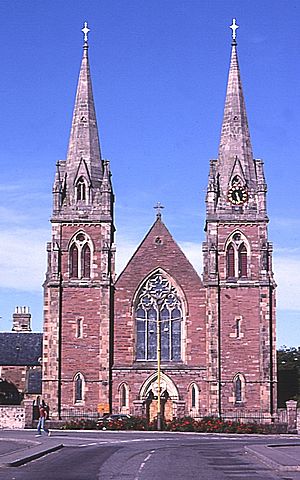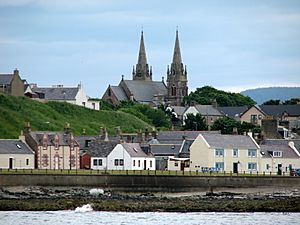St Peter's Roman Catholic Church, Buckie facts for kids
Quick facts for kids St Peter's Roman Catholic Church |
|
|---|---|
| The Buckie Cathedral | |

West elevation
|
|
| Lua error in Module:Location_map at line 420: attempt to index field 'wikibase' (a nil value). | |
| Location | Buckie |
| Country | Scotland |
| Denomination | Roman Catholic |
| History | |
| Founded | 1857 |
| Architecture | |
| Functional status | Active |
| Heritage designation | Category A listed building |
| Administration | |
| Archdiocese | St Andrews and Edinburgh |
| Diocese | Aberdeen |
St Peter's Roman Catholic Church is a very old and large church in Buckie, Moray, Scotland. People in the area often call it the "Buckie Cathedral" because it's so big and impressive. It was built a long time ago, between 1851 and 1857.
This church was built after Catholics in Scotland gained more freedom to practice their religion. It gave the local Catholic community a special place to worship. A Catholic bishop named James Kyle designed the church. The land for the church was given by Sir William Gordon, a local landowner. The church was made bigger and redecorated in the early 1900s by Charles Ménart. In 1972, it was recognized as a very important historic building, called a Category A listed building. St Peter's is still an active church today, managed by the Roman Catholic Diocese of Aberdeen.
Contents
What the Church Looks Like
St Peter's is a huge church built in the Gothic style, which was popular in the 13th century. Because it's so big and stands in a high place, you can see it from miles away! Even though it's a local church, its size makes people call it the "Buckie Cathedral."
The front of the church, facing west, looks very grand and Gothic. It has two square towers on either side of the main entrance. The entrance is set back under a pointed arch. Above this arch is a beautiful stained glass window with four sections and cool geometric patterns. The main part of the church, called the nave, has five sections and aisles on the sides. Light comes in through tall, narrow windows. At the back of the church (the east end) is a smaller, rectangular area called the chancel. It has a large rose window, about 13 feet (4 meters) across, in its wall.
Inside St Peter's Church
The inside of the church is very fancy and decorated in the Gothic style. The main hall, the nave, is tall and narrow. It has arches on both sides that lead to the aisles. These arches are supported by thick columns.
At the west end of the church, there's a gallery that sticks out from the wall. It holds a big pipe organ. Below the organ, you'll find a detailed war memorial that remembers soldiers who died in the First World War. Along the walls of the aisles, there are pictures showing the Stations of the Cross, each in a large, decorative wooden frame. The church's font, used for baptisms, has a heavy stone base and a beautifully carved wooden cover. It's located in a small room called a baptistry in the southwest corner.
The most important part of the church is the chancel. It has very fancy carved decorations behind the altar, made from special stones like Caen stone and polished Languedoc marble. The pulpit, where the priest gives sermons, the altar, and the communion rail are all wonderfully designed using different kinds of marble.
The Priest's House and Walls
The presbytery, which is the house where the priest lives, is connected to the church on the northeast side. It's a two-story house made of red sandstone with a slate roof. The church and the priest's house are surrounded by a tall stone wall. At the front, the wall is lower and has metal railings and a large gate for carriages.
History of the Church
In 1850, Bishop James Kyle of Aberdeen wanted to build a new church in Buckie. More and more Catholic people were living there, and they needed a bigger place to worship. So, Bishop Kyle asked Sir William Gordon, a local Catholic leader, to give some land in the town for the new church.
They made an agreement: Sir William Gordon would provide enough land for the church, a house for the priest, and a school. In return, Sir William and his brother would be buried inside the church when they passed away.
Once the land was ready, construction began in 1851. Bishop Kyle himself drew up the designs, with help from an architectural company called A & W Reid from Elgin. The grand west front of the church was inspired by the old, ruined Elgin Cathedral. It was meant to show how respected Catholics had become in Scotland after gaining more religious freedom.
The church was finished in 1857. A local newspaper, the Banffshire Journal, announced its opening: "Opening of New Catholic Cathedral. The new Catholic Cathedral at Buckie was opened by the Rt Rev Bishop Kyle assisted by Rev Wm Clapperton who was the first missionary therein."
From 1906 to 1907, a Belgian architect named Charles Ménart made the church even bigger. He added the chancel to the east end, making sure to keep and reuse the beautiful rose window from the original church. Ménart also added a small porch to the northwest side and the baptistry to the southwest. He designed the fancy Italian marble high altar and the murals around it. The detailed marble war memorial at the west end of the church was put in place in 1922. It was designed by Cameron McDonald and carved by Nicol Bros of Buckie.
In 1972, St Peter's Church was officially named a Category A listed building, meaning it's a very important historic site. The church's organ was installed in 2000–2001. It was originally made in 1875 for Fort Augustus Abbey by Bryceson Bros. After the abbey closed, the organ was rebuilt and moved to St Peter's by Rushwood and Dreaper.
Current Use
St Peter's Church is still used as a Catholic church today. It is part of a group of parishes that includes Buckie, Fochabers, Tynet, and Presholme. The Roman Catholic Diocese of Aberdeen manages all these churches.


